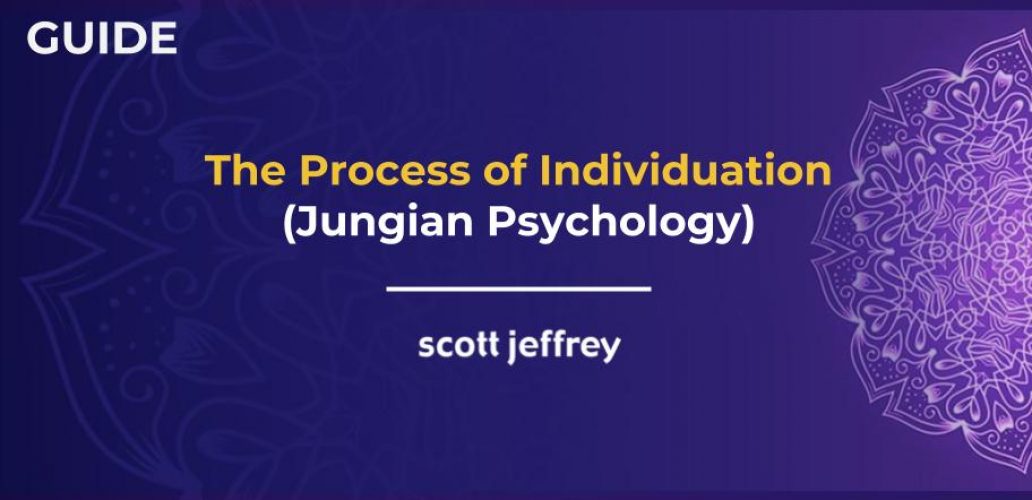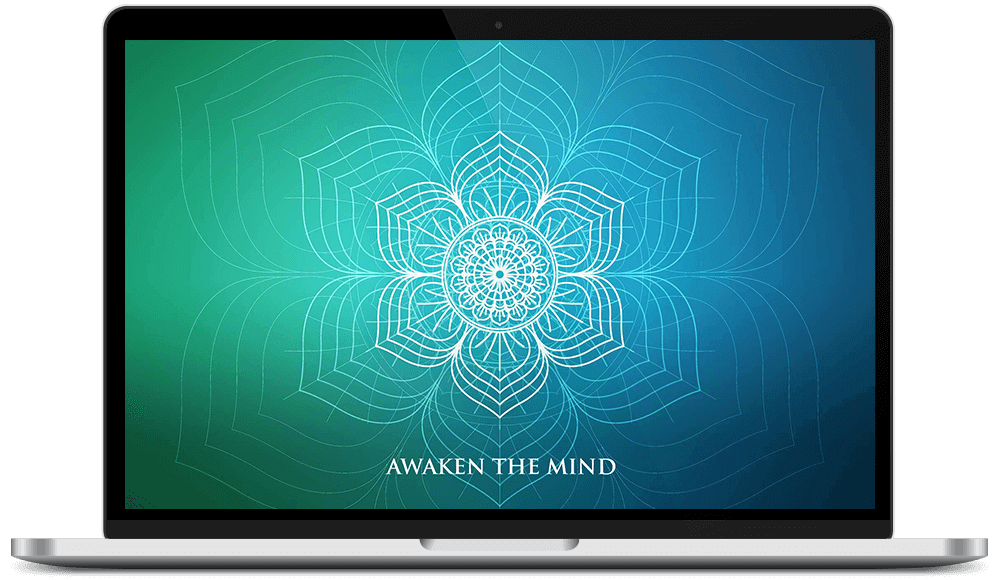
A Closer Look at Carl Jung’s Individuation Process: A Map for Psychic Wholeness
by Scott JeffreyOverview: This guide explores the individuation process as described by Carl Jung and Jungian psychology.
______________
Sigmund Freud was a pioneer in the field of psychology. He named his new field psychoanalysis, as in the study of psychotic and mentally ill patients.
Early in Carl Jung’s career, Freud was like a father figure to him. Freud was grooming the younger Jung to be his successor. But the two men didn’t see eye to eye.
Jung suggested a different name for their emerging field: psycheanalysis. He saw their role as an analysis of the human mind, soul, and spirit.
Jung saw a different picture of the human condition than Freud. Freud perceived his patients to be ill while he, as an analyst, was not. Jung related to his patients, realizing he was in a similar mental condition as his patients.
Jung saw we are all fragmented and divided, and knowingly or not, we’re all searching for our souls.
Table of Contents
- We Start Out Relatively Unconscious (Mostly Asleep)
- Jungian Psychology’s Individuation Process
- The Tension of Opposites
- The Path of Individuation
- Three Stages of the Individuation Process
- Psychological Types
- Tools for the Individuation Process
- Refusing the Call to Individuate
- Individuation: The Pathway to Wholeness
- Additional Reading
- Read Next
We Start Out Relatively Unconscious (Mostly Asleep)
We all start out as part of a collective. As we grow, our family, friends, school, religion, and culture shape our personality.
The Taoists call this personality the acquired mind as we acquire it through our environment.
In the external world, this environment is conventional (as in conventional rules or conventional society).
The conventional code holds specific guidelines of what we should believe, what things mean, and how we should behave.
This conventional, outer world has structure and order.
But within us is an entirely different world. And this inner world, for most of us, is as chaotic as ocean waves during a storm.
Both Freud and Jung called this undifferentiated chaos the unconscious.
The unconscious, we could say, is everything within us that falls outside of our conscious awareness—everything we don’t know or can’t observe within ourselves.
While we want to believe we’re conscious of most of our thoughts, feelings, actions, and behavior, all evidence suggests otherwise. We are, in truth, mostly unconscious beings.
In the beginning, we are mostly asleep. Society conditions our consciousness. And so we remain unconscious to our true self for at least the first half of life.
Jungian Psychology’s Individuation Process
Jung believed each person is unique and has a distinct destiny.
Most of Jungian psychology—also called analytical psychology or depth psychology—centers on what Jung later called the individuation process.
The individuation process was Jung’s way of explaining the path to optimal personal development for an individual.
Jungian analyst Anthony Stevens writes in Private Myths:
Individuation is the process, simple or complex as the case may be, by which every living organism becomes what it was destined to become from the beginning.
The purpose of this individuation process is to increase the individual’s consciousness.
With greater consciousness, individuals can heal the splits in their mind between what’s conscious and unconscious, bringing them to wholeness in their psyche.
In the first half of life, we make our way through the world, doing our best to develop healthy egos.
The first portion of life is mainly external as we seek to meet our basic needs.
From Jung’s outlook, the second part of life can represent a turning inward toward a deeper part of ourselves.
This inward turn starts the individuation process.
The Tension of Opposites
Prior to beginning the individuation process, we have certainty. Through the course of our development, we form a solid self-identity. We think we know who we are.
But this self-identity is always one-sided. It’s an illusion, or maya, as the Buddhists call it.
Because we are unconscious, we don’t feel the inherent tensions and oppositions between the conscious self we know and the unconscious parts of ourselves.
You’re probably familiar with the Taoist symbol of yin and yang. This ancient symbol represents the balance or harmony of opposites.
Yang is the sunny light side while yin represents the shadowy side.

Instead of seeing yin and yang as opposing forces, the Chinese view them as complementary forces that interact within a greater whole (represented by the circle encompassing them).
Consider how the values and worldviews of masculine and feminine principles can vary.
The masculine seeks autonomy. The feminine seeks communion or relationship.
Can you imagine what it would be like to integrate both masculine and feminine principles within your mind, not favoring either perspective over the other?
It’s not easy, but this is part of the goal of the individuation process.
Jung found that opposites create tension in the psyche. If we don’t learn to address these tensions, denying the opposites instead, we repress or push the pressure out of our consciousness.
But repressing doesn’t eliminate the opposites or the tension itself. It only makes them more destructive in our psyche by strengthening our shadows.
Repressing tension makes us one-sided, and it leads us to project our unconscious fantasies on to reality.
When we deny these internal tensions, we enforce our delusions and self-deception.
Besides the tension between masculine and feminine principles, here are two other common internal tensions:
Instincts and Psyche
A key pair of opposites in Jung’s work are instincts and psyche.
The instincts are our biological roots, our body. The psyche, in Jung’s conception, is the totality of mental processes that include both conscious and unconscious forces.
Any time we try to favor psyche over instincts—mind over body, spirit over nature—or vice versa, we cut ourselves off (dissociate) from a part of what we are.
Good and Evil
Most of us prefer pursuing “good” while avoiding “evil.” We want to realize God and cast out the Devil. We want angels, not demons.
Jung points out in Aion that evil had a different meaning before Christianity.
The rise of Christianity added a kind of spirit of evil to the principle of evil which it did not have before. The sharpening of differentiation of ethical reactions into too clear-cut black-and-white lines is not favorable to life.
As the Greek philosopher Heraclitus said, “Good and evil are one.”
The Path of Individuation
Individuation is Jung’s solution to our tendency toward one-sidedness.
In this process of becoming a complete human being, we integrate all the parts of our personality of which we aren’t presently conscious.
Why did Jung call the process “individuation”?
Jungian psychologist Robert Johnson explains in Inner Work:
Because this process of actualizing oneself and becoming more complete also reveals one’s special, individual structure. It shows how the universal human traits and possibilities are combined in each individual in a way that is unlike anyone else.
Jung writes in Two Essays on Analytical Psychology:
Individuation means becoming an “in-dividual,” and, in so far as “individuality” embraces our innermost, last, and incomparable uniqueness, it also implies becoming one’s own self. We could therefore translate individuation as “coming to selfhood” or “self-realization.”
Johnson points out that individuation doesn’t mean we become isolated from the human race. He writes,
Once we feel more secure as individuals, more complete within ourselves, it is natural also to seek the myriad ways in which we resemble our fellow human beings … the essential human qualities that bind us together in the human tribe.
As we individuate, we connect and identify with the entire human family.
Three Stages of the Individuation Process
While the individuation process is different for each person, Jung highlights three archetypes that coincide with three stages of psychological development.
Stage 1: The Shadow
The shadow archetype represents all the personal traits we have ignored, denied, or cut off from ourselves.
Individuals first get to know and integrate their shadow—all the disown parts of themselves they alienated to create their personality.
In The Portable Jung, Joseph Campbell explains:
Jung’s concept is that the aim of one’s life, psychologically speaking, should be not to suppress or repress, but to come to know one’s other side, and so both to enjoy and to control the whole range of one’s capacities; i.e., in the full sense, to “know oneself.”
See: A Complete Guide to Shadow Work
Stage 2: The Anima/Animus
The anima is the feminine component of a man’s personality. The animus is the masculine counterpart in a woman.
Jung saw the anima/animus as enlivening souls or spirits within men and women.
They are, as Robert Johnson says, “the interior companion or inspirer of life.”
This archetype connects us to the impersonal collective unconscious. To Jung, they are essential building blocks in the psychic structure of every man and woman.
In The Archetypes and the Collective Unconscious, Jung termed integrating shadow as the “apprentice-piece” of becoming whole while the integration of the anima or animus is the “master-piece.”
Stage 3: The Self
The Self is the archetype of wholeness and self-transcendence. A Wise Old Man or Woman often represents this universal image.

Gandalf, the Wise Old Man, from J.R.R. Tolkien’s The Lord of the Rings
Jung borrowed the concept of the Self from Hindu philosophy. He described the Self as the “totality of the whole psyche,” distinguishing it from the ego.
The ego represents a small part of this whole psyche.
Think of the Self as an unknown, inner Divine center we explore throughout our lives.
See: The Ultimate List of Archetypes
Psychological Types
Whereas most of the self-improvement industry offers “one-size-fits-all” solutions, Jung understood the complexities of the human psyche.
Jung differentiated various orientations—ways in which an individual can process information, make decisions, and interpret the world.
An individual’s combination of these orientations highlighted their path to individuation.
Introversion versus Extraversion
The majority of people put an emphasis on the outer world, on the pleasures and restrictions “out there.”
Jung labeled this group extroverts as they draw energy from others in their environment.
But a smaller percentage of individuals emphasize the inner world, on their subjective responses to outside events.
Jung called these individuals introverts as they draw energy from within themselves.
Extroverts move out toward the world while introverts instinctively pull back into themselves.
Jung realized that each person has a predisposition to one of these two approaches to life.
The Four Functions
Jung observed that some people favor thoughts to pass judgment while others follow their feelings.
Some individuals experience the world through their senses while others intuit intentions, potentials, and hidden relationships.
Thinking types approach life with little regard for their emotions. They arrange things with logic and order. They have firm codes of what’s right and wrong.
Feeling types understand what something is worth. Compared to thinker’s clear categories of thought, feelers embrace disorder. They appreciate the infinite gradations of value and meaning.
Sensing types most accurately interpret information through their five senses. They are the ultimate realists, accepting the world as it is.
Intuiting types are more interested in future possibilities than in things as they are. Intuitives see similarities where most people see differences.
Note: For more information, see Jung’s Psychological Types. Myers and Briggs used these psychological types by to create their typing assessment.
Jung, however, did not agree with Myers and Briggs’ application of his psychological types.
Superior Function versus Inferior Function
We like to do things we’re good at and avoid doing things in which we feel inadequate. And so we develop specific skills while undeveloped talents remain in the unconscious.
Jung grouped these four functions into pairs: thinking and feeling, sensing and intuiting.

Of the four functions, Jung found that each person has one dominant or superior function.
The opposite function is the person’s inferior function. This inferior function remains mostly unconscious to the individual.
For example, for people who rely on thinking to interpret information, feelings represent their inferior function.
For people who trust their senses, intuition is their inferior function.
Remember the goal of the individuation process is to integrate the conscious with the unconscious.
Our superior function is conscious—we know our strengths. Our inferior function is unconscious because, in the course of our development, we’ve avoided it.
And so the key to individuation, according to Jung, lies in developing our inferior function.
As Campbell writes in The Portable Jung:
‘Individuation’ is Jung’s term for the process of achieving such command of all four functions that, even while bound to the cross of this limiting earth, one might open one’s eyes at the center, to see, think, feel and intuit transcendence, and to act out of such knowledge.
Tools for the Individuation Process
How do we proceed with our psychological development toward individuation?
Jungian psychology offers two related methods: dream work and active imagination.
Dream Work
Dreams, Jung found, are the gateway through which the unconscious communicates with our conscious mind.
Our inner Wise Old Man or Woman (the Self) knows what’s best for us.
The Self, however, cannot communicate in language. Instead, it uses symbols and images.
The Self cannot communicate directly with our conscious mind. Instead, according to Jungian psychology, it sends us messages through our dreams.
As Jungian analyst Marie-Louise von Franz says in The Way of the Dream, “Dreams are the letters of the Self that the Self writes us every night.”
Stevens confirms in Private Myths:
Jung maintained that a crucial factor determining how conscious we are is whether we attend to our dreams and the degree to which this enables us to make what is unconscious conscious. By working with dreams we ‘create soul’, we ‘wake up’ to our total situation, ‘become conscious’, achieve ‘wholeness’.
Active Imagination
While in dreams, our dream ego interacts with the unconscious parts of our psyche, in active imagination this interaction takes place while we’re awake.
Instead of going into a dream, we go into our imagination, allowing the images to arise from the unconscious and communicate with us.
Note: If you’re interested in pursuing the individuation process, I recommend Robert Johnson’s Inner Work for practical instruction on dreamwork and active imagination.
See also my guide: How to Use Archetypes and Active Imagination to Increase Consciousness
Refusing the Call to Individuate
Although Jungian psychology and the individuation process can liberate us, it’s not a “safe path.” There’s no safety once we leave the everyday world.
Plus, to achieve success, we must strip away all of our false identities our egos have invested in creating. Doing so triggers fear from our ego.
That’s why most people resist their call to adventure and why, according to Jung, so few people individuate (achieve psychic wholeness).
Jung writes in The Secret to the Golden Flower:
The way is not without danger. Everything good is costly, and the development of the personality is one of the most costly of all things.
But, Jung believed, it can lead us out of the hall of mirrors and return us to our Self.
Individuation: The Pathway to Wholeness
To Jung and Maslow, the purpose of life was to realize one’s potential and to become a whole person in one’s own right.
To realize this purpose, we must reconnect with the divine Self within us.
As Jungian psychologist Edward Edinger writes in Ego and Archetype:
Psychological development in all its phases is a redemptive process. The goal is to redeem by conscious realization, the hidden Self, hidden in unconscious identification with the ego.
Through this individuation process, we not only achieve positive mental health, but we also become harmonious, mature, responsible adults.
To assist in this process, get rooted in your Center and enter a state of mastery as often as possible. See The Mastery Method.
Additional Reading
Inner Work by Robert Johnson
Ego and Archetype by Edward Edinger
The Portable Jung edited by Joseph Campbell
See also: 10 Best Books in Psychology to Learn the Forces That Drive You
Read Next
How to Use Spiral Dynamics for Psychological Development
Psychological Projection: Reclaiming the Best Parts of Yourself
How to Cultivate Self Leadership by Developing Your Emotional Intelligence
How to Use the Psychology of Archetypes Psychology to Increase Consciousness











